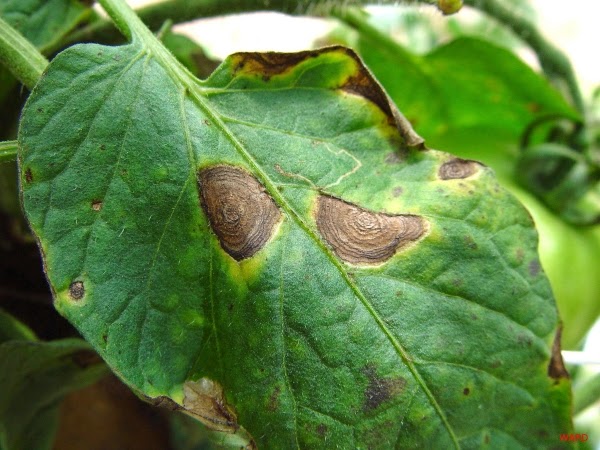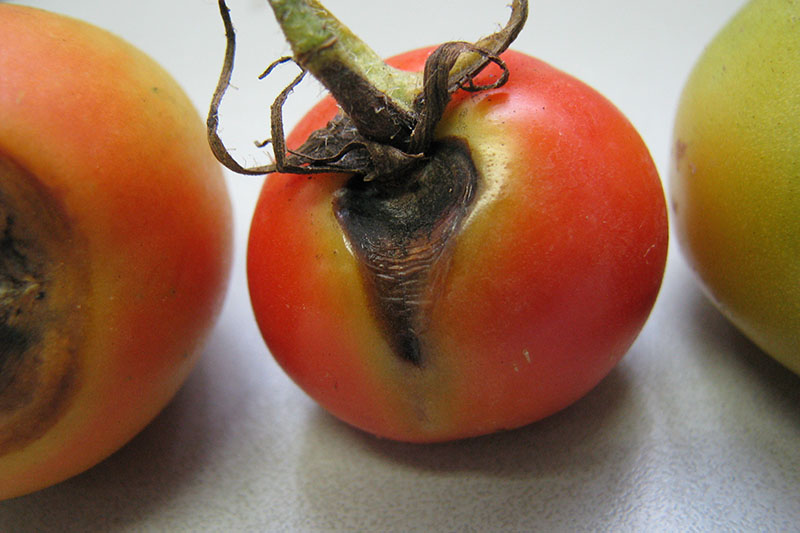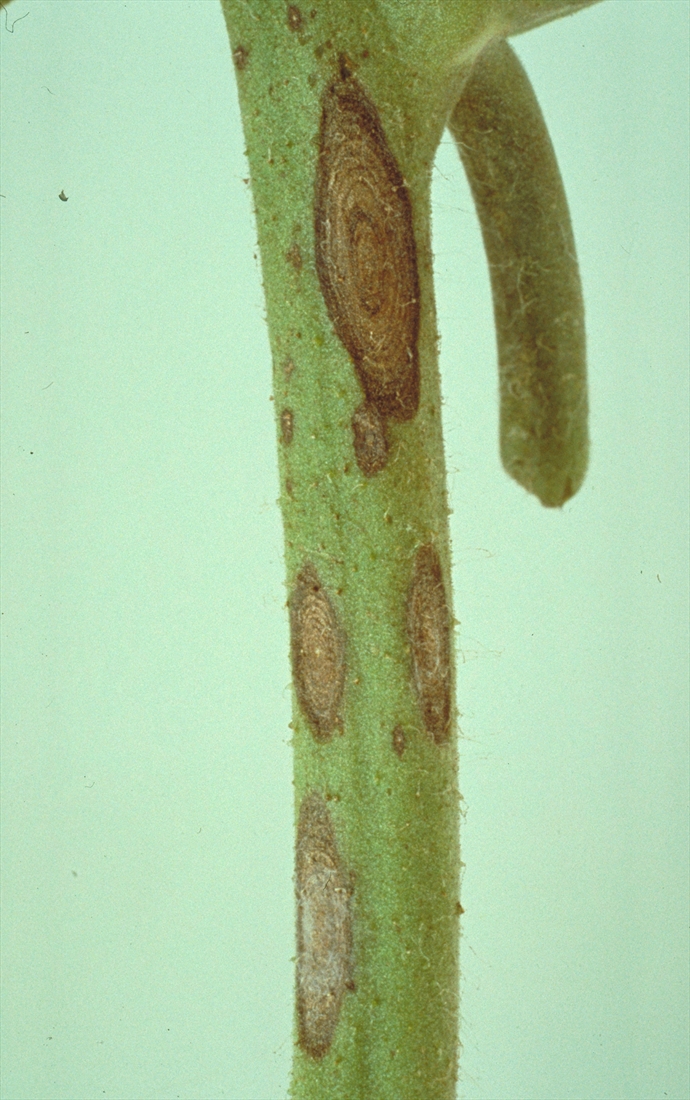
Early Blight
Alternaria Solani
Pathogène :
Fungus
Type:
Risque:
HIGH
Alternariosis


QUI EN EST LA CAUSE ?
Alternaria solani is a phytopathogenic fungus responsible for causing early blight in various plants, especially tomato. This pathogen is characterized by the production of conidia, which are asexual spore-shaped structures, which are spread mainly by wind and water. Conidia germinate in the presence of humidity, penetrating plant tissues through wounds or natural openings such as stomata. Once inside the plant, the fungus develops, producing mycelium that expands inside the plant tissue, decomposing it and extracting nutrients. During periods of high humidity, Alternaria solani produces new spores in lesions, perpetuating the cycle of infection. This pathogen is particularly active in warm, humid climates, where it can survive in the remains of infected plants or in the soil, waiting for favorable conditions to restart the infection in the following season.
SYMPTÔMES
Early blight caused by Alternaria solani affects tomato plants, compromising their health and productivity. Initial symptoms usually appear on older leaves, where circular brown Taches with concentric rings form, giving a "bullseye" appearance. These Taches can converge, causing the death of the affected tissue and premature defoliation. Under severe conditions, early blight can spread to the stems and fruits, causing necrosis and a decrease in the quality and quantity of the crop.
- Circular brown Taches with concentric rings on the leaves.
- Premature defoliation.
- Necrosis in stems and fruits.
- Decrease in plant growth.
- Fruits with sunken black Taches and leathery texture.
- Premature fall of flowers and fruits.


TEMPÉRATURE ET HUMIDITÉ
20-30°C
70-90%
VOIES DE TRANSMISSION
Wind, irrigation water, contaminated tools, contact with infected plant remains, infested soil
Do you want to remove this pest? Choose how you want to treat it.
TRAITEMENTS
Traitements chimiques
• AZOXISTROBIN 20% + DIFENOCONAZOLE 12.5% [SC] P/V
• AZOXISTROBIN 25% [SC] P/V
• CAPTAN 47.5% [SC] P/V
• CAPTAIN 80% [WG] P/P
• CYMOXANIL 2.85% + FOSETIL-AL 30% + COPPER OXYCHLORIDE 16% (EXPR. IN CU) [WG] P/P
• CYMOXANIL 3% + CUPROCALCIC SULFATE 22.5% (EXPR. IN CU) [WP] P/P
• CYMOXANILE 4% + FOLPET 25% + FOSETIL-AL 50% [WG] P/P
• DIFENOCONAZOLE 1.67% [EC] P/V
• DIFENOCONAZOLE 12.5% + CYFLUFENAMIDE 1.5% [DC] P/V
• DIFENOCONAZOLE 25% [EC] P/V
• FLUXAPYROXAD 7.5% + DIFENOCONAZOLE 5% [SC] P/V
• FOLPET 50% [SC] P/V
• FOLPET 50% [WP] P/P
• FOLPET 80% [WG] P/P
• CUPRIC HYDROXIDE 13.6% (EXPR. IN CU) + COPPER OXYCHLORIDE 13.6% (EXPR. IN CU) [SC] P/V
• CUPRIC HYDROXIDE 20% (EXPR. IN CU) [WG] P/P
• CUPRIC HYDROXIDE 25% (EXPR. IN CU) [WG] P/P
• CUPRIC HYDROXIDE 30% (EXPR. IN CU) [WG] P/P
• CUPRIC HYDROXIDE 35% (EXPR. IN CU) [WG] P/P
• CUPRIC HYDROXIDE 36% (EXPR. IN CU) [SC] P/V
• CUPRIC HYDROXIDE 40% (EXPR. IN CU) [WG] P/P
• CUPRIC HYDROXIDE 50% (EXPR. IN CU) [WG] P/P
• CUPRIC HYDROXIDE 50% (EXPR. IN CU) [WP] P/P
• Mandipropamide 25% + DIFENOCONAZOLE 25% [SC] P/V
• METALAXIL 8% + COPPER OXYCHLORIDE 40% (EXPR. IN CU) [WP] P/P
• METIRAM 70% [WG] P/P
• COPPER OXYCHLORIDE 25% (EXPR. IN CU) [WG] P/P
• COPPER OXYCHLORIDE 30% (EXPR. IN CU) [WP] P/P
• COPPER OXYCHLORIDE 35% (exp. in Cu) [WG] P/P
• COPPER OXYCHLORIDE 35% (EXPR. IN CU) [WG] P/P
• COPPER OXYCHLORIDE 37.5% (EXPR. IN CU) [WG] P/P
• COPPER OXYCHLORIDE 38% (EXPR. IN CU) [SC] P/V
• COPPER OXYCHLORIDE 50% (EXPR. IN CU) [WG] P/P
• COPPER OXYCHLORIDE 50% (EXPR. IN CU) [WP] P/P
• COPPER OXYCHLORIDE 52% (EXPR. IN CU) [SC] P/V
• COPPER OXYCHLORIDE 70% (EXPR. IN CU) [SC] P/V
• COPPER OXYCHLORIDE 70% [SC] P/V
• CUPROUS OXIDE 50% (EXPR. IN CU) [WP] P/P
• PIRACLOSTROBIN 6.7% + BOSCALIDE 26.7% [WG] P/P
• CUPROCALCIC SULFATE 20% (EXPR. IN CU) [WG] P/P
• CUPROCALCIC SULFATE 20% (EXPR. IN CU) [WP] P/P
• CUPROCALCIC SULFATE 20% (EXPR. IN CU) [WG] P/P
• CUPROCALCIC SULFATE 20% [WP] P/P
• TRIBASIC COPPER SULFATE 19% (EXPR. IN CU) [SC] P/V
• TRIBASIC COPPER SULFATE 40% (EXPR. IN CU) [WG] P/P
• ZOXAMIDE 5.88% + COPPER OXYCHLORIDE 25% (Exp. in Cu) [WG] P/P
Traitements autorisés en agriculture biologique
• CUPRIC HYDROXIDE 13.6% (EXPR. IN CU) + COPPER OXYCHLORIDE 13.6% (EXPR. IN CU) [SC] P/V
• CUPRIC HYDROXIDE 20% (EXPR. IN CU) [WG] P/P
• CUPRIC HYDROXIDE 25% (EXPR. IN CU) [WG] P/P
• CUPRIC HYDROXIDE 30% (EXPR. IN CU) [WG] P/P
• CUPRIC HYDROXIDE 35% (EXPR. IN CU) [WG] P/P
• CUPRIC HYDROXIDE 36% (EXPR. IN CU) [SC] P/V
• CUPRIC HYDROXIDE 40% (EXPR. IN CU) [WG] P/P
• CUPRIC HYDROXIDE 50% (EXPR. IN CU) [WG] P/P
• CUPRIC HYDROXIDE 50% (EXPR. IN CU) [WP] P/P
• COPPER OXYCHLORIDE 25% (EXPR. IN CU) [WG] P/P
• COPPER OXYCHLORIDE 30% (EXPR. IN CU) [WP] P/P
• COPPER OXYCHLORIDE 35% (exp. in Cu) [WG] P/P
• COPPER OXYCHLORIDE 35% (EXPR. IN CU) [WG] P/P
• COPPER OXYCHLORIDE 37.5% (EXPR. IN CU) [WG] P/P
• COPPER OXYCHLORIDE 38% (EXPR. IN CU) [SC] P/V
• COPPER OXYCHLORIDE 50% (EXPR. IN CU) [WG] P/P
• COPPER OXYCHLORIDE 50% (EXPR. IN CU) [WP] P/P
• COPPER OXYCHLORIDE 52% (EXPR. IN CU) [SC] P/V
• COPPER OXYCHLORIDE 70% (EXPR. IN CU) [SC] P/V
• COPPER OXYCHLORIDE 70% [SC] P/V
• CUPROUS OXIDE 50% (EXPR. IN CU) [WP] P/P
• CUPROCALCIC SULFATE 20% (EXPR. IN CU) [WG] P/P
• CUPROCALCIC SULFATE 20% (EXPR. IN CU) [WP] P/P
• CUPROCALCIC SULFATE 20% (EXPR. IN CU) [WG] P/P
• CUPROCALCIC SULFATE 20% [WP] P/P
• TRIBASIC COPPER SULFATE 19% (EXPR. IN CU) [SC] P/V
• TRIBASIC COPPER SULFATE 40% (EXPR. IN CU) [WG] P/P
Traitements biologiques
• BACILLUS AMYLOLIQUEFACIENS (strain FZB24) 13% [WP] P/P
• BACILLUS AMYLOLIQUEFACIENS (MBI 600 strain) 11% [WP] P/P
• BACILLUS SUBTILIS (STRAIN QST 713) 1.34% [SC] P/V
Recommandations
- Use tomato varieties resistant to Alternaria solani.
- Implement crop rotations to reduce the presence of the pathogen in the soil.
- Remove and destroy the remains of infected crops to prevent the spread of the fungus.
- Avoid sprinkler irrigation and prefer drip irrigation to reduce humidity in the foliage.
- Apply preventive and curative fungicides, following an integrated pest management program.
- Ensure adequate ventilation in crops to reduce relative humidity.
- Maintain adequate spacing between plants to promote air circulation.
- Regularly inspect crops to detect and treat symptoms early.
- Use padding and mulches to avoid direct contact of the leaves with the ground.
- Promote ecological management practices, such as the use of biocontrollers and biological products.
Enlace patrocinado
Enlace patrocinado
Enlace patrocinado
Enlace patrocinado
Enlace patrocinado
Enlace patrocinado
Effective against all types of fungi
TRAITEMENTS
Remèdes maison
There are no home treatments
Alliés naturels
Traitements chimiques
There are no treatments for this disease. Treatments are directed at the insect vectors that transmit it. See insect treatments.
RECOMMANDATIONS
- Check the back of the leaves frequently, especially in dry weather.
- Spray water on the leaves to increase humidity and prevent them from settling.
- Keep plants healthy with good watering and adequate light.
- If you see cobwebs or damage, clean the leaves with a damp cloth or pressurized water.
- Use potassium soap or neem oil every few days until they disappear.
Plantes répulsives
Rosemary, Dill, Coriander
PRODUITS RECOMMANDÉS
Enlace patrocinado
Enlace patrocinado
Enlace patrocinado
Enlace patrocinado
Enlace patrocinado
Enlace patrocinado
Effective against all types of fungi
*Les traitements recommandés sont des recommandations basées sur les bases de données des autorités et ne remplacent en aucun cas les lignes directrices établies par la législation de chaque pays.
*Les produits présentés sont des recommandations et ne sont pas nos propres produits. En tant qu'associés Amazon, nous gagnons des revenus grâce aux achats de produits recommandés.




















